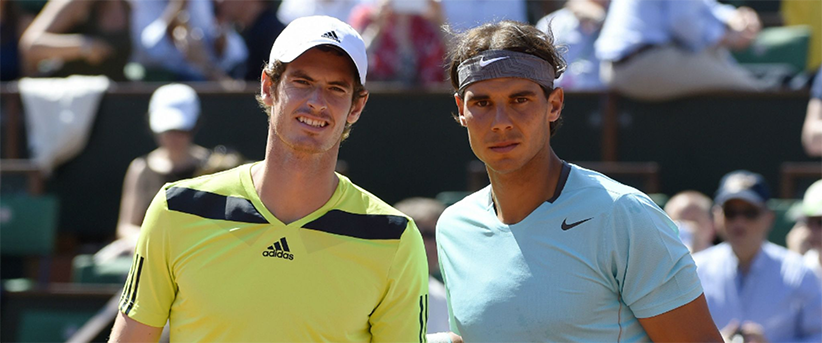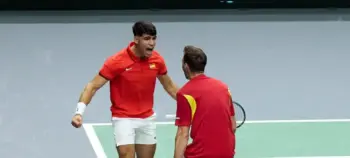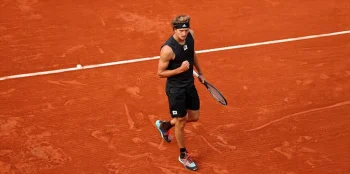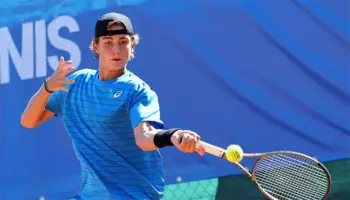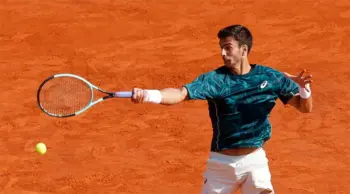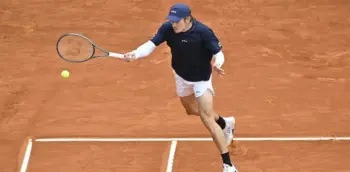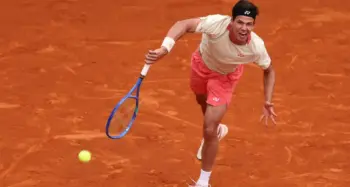As I look back on the past two decades of the Wimbledon Championships, one of the most staggering facts in the men’s game is the stranglehold of the big four on this trophy. Since 2003, no man not named Roger Federer, Rafael Nadal, Novak Djokovic or Andy Murray had lifted that trophy right until last year in 2023, when Carlos Alcaraz finally broke that barrier in his first Wimbledon final by beating Novak Djokovic in a 5-set thriller.
We know that 15 out of those 20 titles (during the period 2003-22) were won by Roger Federer (8) and Novak Djokovic (7) and these two have dominated grass like none other in the open era (barring Pete Sampras who won 7 titles in 8 years during 1993- 2000). However, the question that comes to mind is that who amongst the other two members of the big four (who won the 4 other times during 2003-22*), has been the better overall player on grass?
As the sun sets on the careers of these two legends, Rafael Nadal and Andy Murray, on the lush green lawns, I’ll try to do a comparison of their grass court achievements. The 2024 Wimbledon Championships are probably the last time (at best) we’ll witness Andy Murray stepping on to a grass court. And Rafael Nadal’s gutsy fight back in the Wimbledon 2022 quarterfinal vs Taylor Fritz, while suffering from an abdominal injury, was most likely his last match on a grass court as well.
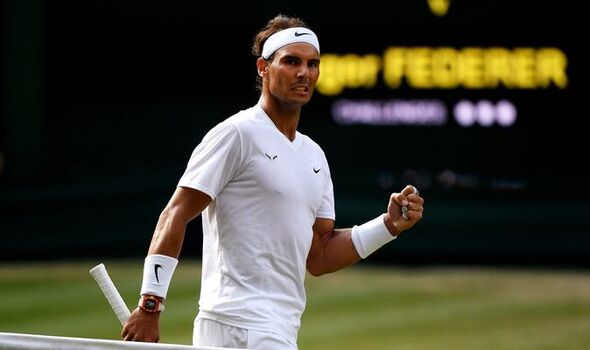
Both players started their pro-career on grass at near about the same time, Nadal in 2003 and Murray in 2005. Given that Nadal’s career has been more injury-prone and the fact that the grass season commences right after a long clay season (his favoured surface), he has missed more tournaments on grass and hence has played only 96 matches on the surface compared to Murray’s 149 till Jun 30, 2024. Also, the number of tournaments played on grass is only 25 for Nadal vs 38 for Murray.
The entire grass season lasts for only 3 weeks and hence there are only 4 to 5 important tournaments in the run-up to Wimbledon, two of them being the Halle Open (ATP 500)* and the Queen’s Club Championships (ATP 500). Murray and Nadal both, have usually favoured playing at Queen’s club during the run-up to Wimbledon. Let’s first look at the number of titles won by each of them along with the breakdown of the specific titles.
*1. Wimbledon 2020 was cancelled because of the Covid-19 pandemic
*2. Both, Halle Open and the Queen’s Club Championships were upgraded to an ATP 500 tournament starting 2015, prior to that they were ATP 250 tournaments
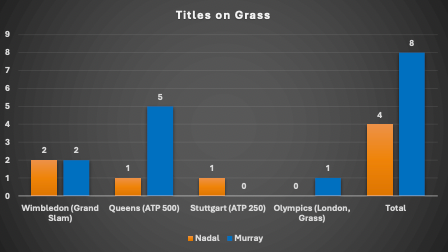
Murray seems to be the more consistent player over the years, largely due to his better results during the warm up tournaments prior to Wimbledon. He has won Queen’s a record 5 times, which is the highest ever. But Nadal has played at Queen’s/Halle only 9 times (6 times at Queen’s and 3 times at Halle) compared to Murray’s 15 appearances at Queen’s. However, Murray’s 8 titles also include a coveted Olympic Gold in Singles at the 2012 London Olympics, which were played on grass at Wimbledon, where he beat Roger Federer in the final (the reigning and overall 7-time Wimbledon champion at that time). Please note that we are ignoring Nadal’s Olympic Gold in Singles at the 2008 Beijing Olympics as they were played on hard courts.
The win percentages on the surface should also be given high weightage. There is nothing between the two players in terms of career match win% on the surface and the Wimbledon match win%, as shown below.
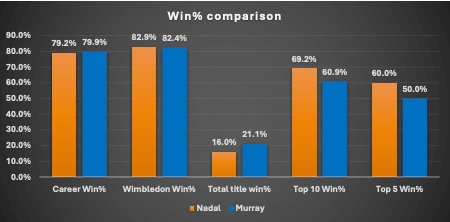
Murray has a higher title win% (tournaments won/tournaments played) of 21.1% (8/38) than Nadal’s 16.0% (4/25). And this is after including Murray’s 8 tournament appearances post his near career-ending resurfacing hip surgeries in 2018 and 2019. We all know that he has not been the same player post the hip injury and hence his numbers in terms of win% across tournaments and opponents would have been much better had he retired after the surgeries itself or reached his pre-surgery level. If we exclude all his matches played after Wimbledon 2017, his career win% also goes up to 84.8% (106 wins to 19 losses).
Nadal’s play against quality opponents has been top notch as he has the higher top 10 win% (9/13; 69%) and top 5 win% (6/10; 60%) on the surface compared to Murray’s 61% (14/23) and 50% (6/12).
While we have analysed the title wins and match win percentages, there is no doubt that the performances at Wimbledon have to be given more weightage, as it is a significant part of the short grass court season.
While both players have won the same number of Wimbledon titles, Nadal made it to more number of finals (5 vs 3) and semi-finals (8 vs 7) at SW19. Also, they have played each other only three times on grass, all at Wimbledon, and Nadal leads the H2H 3-0. These Wimbledon match-ups were in the 2008 QF (Nadal winning in straight sets), 2010 SF (Nadal winning in straight sets) and the 2011 SF (Nadal winning in 4 sets). Though Murray lost all these matches, this was against a peak Nadal (who went on to win Wimbledon in two out of these three years and lost in the final in the third year to Djokovic) on grass and Murray was still finding his feet against the big 3.
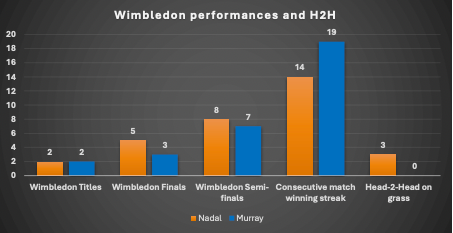
The dominance in terms of consecutive match winning streaks has relatively lower weightage compared to other parameters. Murray had a more dominant streak in terms of 19 consecutive match wins on the surface starting from the London Olympics 2012 (Rd of 64) till Queen’s 2014 (Rd of 32). Murray had another 14-match winning streak from 2015 Davis Cup till the 2016 Wimbledon final. Nadal’s longest winning streak on the surface was of 14 matches from Queen’s 2008 (Rd of 32) till Queen’s 2010 (Rd of 16).
The result distribution below gives a more detailed depiction of the results achieved by each player at Wimbledon. We can infer that Nadal has been more clinical when he’s reached the latter stages (SF and beyond) of Wimbledon. He has at least reached the final in 1/3rd of his total appearances and at least reached the semi-finals in more than half of his appearances. While Murray’s semi-final appearances are comparable, he has lost more during that stage, making it to only 3 finals compared to Nadal’s 5.
However, Rafa has also had some shocking early round losses to lower ranked players (during 2012-2017), thus failing to reach the quarter-finals in nearly half of his appearances (7/15) and not even getting past the second round in 27% (4/15) of these appearances. Murray has been more consistent in terms of reaching the second week, making it to at least the quarter-finals in 2/3rd of his appearances (10/15) compared to Rafa at 53% (8/15).
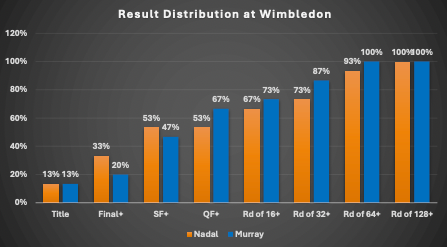
We cannot forget that Rafael Nadal beat peak Roger Federer in that heroic Wimbledon 2008 final (watch below) when Federer was going for an all-time record of a 6th straight title at the Championships. Federer was also on an unprecedented 65-match winning streak on grass at that time, having not lost a single match on grass in 5 years since Halle 2003 (Rd of 32)!
The comparison has been neck and neck. To conclude, here is a summary of the parameters discussed above and the respective player coming out on top for each parameter.
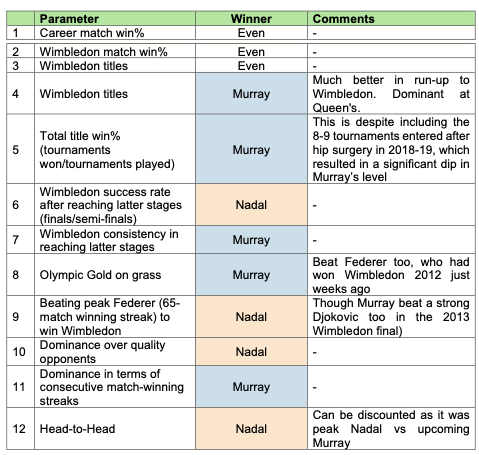
It is difficult to make a conclusion definitively as both players have demonstrated unbelievable skill on the surface for more than a decade. Though I would rate peak Nadal higher than peak Murray on grass, but based on the consistent performances at Wimbledon and Queen’s and the important title wins overall, I would rate Murray slightly above Nadal as a grass court player.
Let me know your thoughts in the comments section!
